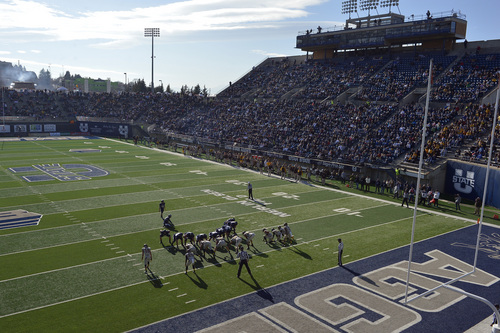This is an archived article that was published on sltrib.com in 2014, and information in the article may be outdated. It is provided only for personal research purposes and may not be reprinted.
The long-awaited renovations to Romney Stadium are another small step closer to fruition, Utah State announced Friday afternoon.
The university's Board of Trustees have formally approved plans to update the venerable stadium, which the athletics department hopes to modernize with luxury seating, a new press box, concession stands, restrooms and other facilities. It's an early step, but an important one that allows athletic director Scott Barnes and his staff to move forward on funding models for what could amount to the most ambitious facilities project of his tenure.
"Our objective is to formalize our revenue model to better understand the scope of the project we can fund," Barnes said in the school news release. "Ultimately, I see two phases, and we need to answer the question of what potential funding might buy in phase 1, in addition to new premium seating, club amenities and a press box structure. And, how soon can we get started on design."
The big development from the Trustees' approval is that a study from consulting firm Conventions, Sports and Leisure International determined that the renovation was financially feasible. A market and financial analysis from CSL helped greenlight the project. Barnes also presented "design and program concepts" from VCBO Architects.
Barnes said last fall that he felt that Utah State had directed a lot of energy at improving the athlete experience through construction: a football complex, a weight room, a soon-to-be-opened basketball and volleyball complex. The Aggies are now trying to improve the fan experience.
That starts with overhauling Romney, a distinct but 46-year-old venue that hasn't quite been able to fully serve its 25,500-fan capacity. There's also not much in the way of premium seating in Romney, save for the football complex suites in the North end zone. Utah State believes adding suites and box seating could open an important revenue stream for the university.
In November, Barnes estimated that the first phase of the project could cost between $20 and $25 million. Starting the project may require the largest lead gift in Utah State athletics history, so finding a reliable funding model will be the most critical step of the process.
Kyle Goon
kgoon@sltrib.comTwitter: @kylegoon



